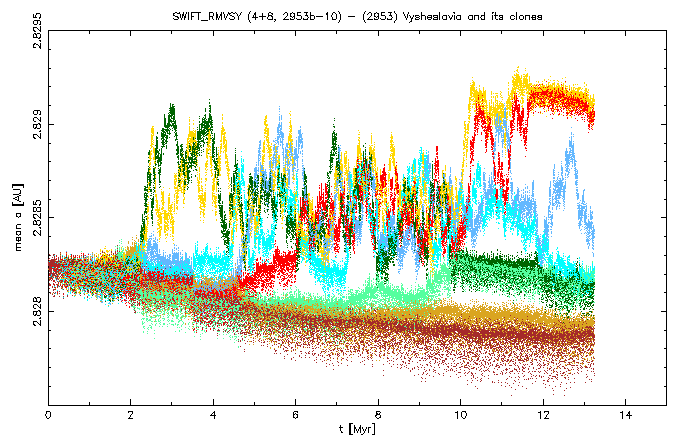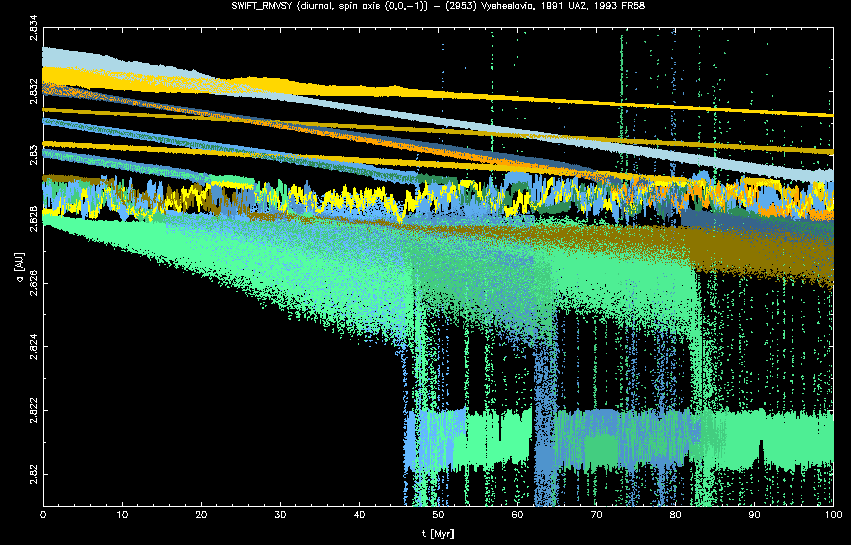
We present partial results of numerical integrations of three asteroids belonging to Koronis family: (2953) Vysheslavia, 1991 UA2, 1993 FR58. This group of asteroids is located near the strong 5:2 resonance with Jupiter and three mentioned asteroids are very close to its outer border.
First, we have performed some test integrations, our aim was to reproduce results presented in Milani and Farinella (1995) and Knezevic et al. (1997). The initial orbital elements of test particles for epoch 2450000.5 are as follows:
a e i peri node m 2.8285426 0.0214657 1.07030 13.45195 251.83611 253.03192 2.8308008 0.0302394 1.09000 210.89036 303.82036 184.46377 2.8322749 0.0894712 1.01236 190.78036 237.04962 298.48064
.3870981687 .2056409518 7.00522131 29.1138808 48.3366265 334.18176132 .7233302589 .0067406944 3.39481240 54.7623245 76.6916158 96.03522208 .9999892694 .0167504472 .00051835 117.5694142 345.4163055 275.20711676 1.5237606005 .0933764710 1.85005003 286.4303735 49.5745143 290.07750045 5.2024651071 .0484029017 1.30463707 275.2441445 100.4697061 250.33307890 9.5517920529 .0523353158 2.48540245 337.3153449 113.6444013 267.25484458 19.2934568720 .0448362005 .77332890 102.5552393 74.0867669 118.40584733 30.2582035933 .0079834915 1.77009560 231.2849840 131.7748206 292.50401417 39.7980953111 .2544099743 17.12042863 114.2951275 110.3865961 8.25563829

100 Myr integration of 15 asteroids (three real and their clones) including Yarkovsky diurnal drag (seasonal variant is suppresed by the selected orientation of spin axis). Thermal properties of asteroids are selected in that way to produce maximal drift rates in semimajor axes - like reglith covered asteroids. Radii are calculated from absolute magnitudes and expected albedo 0.2.
| radius | bulk density |
surface density |
thermal conductivity |
specific heat |
albedo | emissivity | period [h] | spin axis orientation |
|
| 2953 Vysheslavia | 7500 | 3500 | 1500 | 0.0015 | 680 | 0 | 1 | 10 | (0,0,-1) |
| 1991 UA2 | 2800 | 3500 | 1500 | 0.0015 | 680 | 0 | 1 | 5 | (0,0,-1) |
| 1993 FR58 | 3000 | 3500 | 1500 | 0.0015 | 680 | 0 | 1 | 5 | (0,0,-1) |
Notice an existence of 0.001 AU thin region, where asteroids exhibit a chaotic changes of semimajor axis. It is a typical stable chaos behavior. The resonance itself seems to be slightly separated from this area.
 |
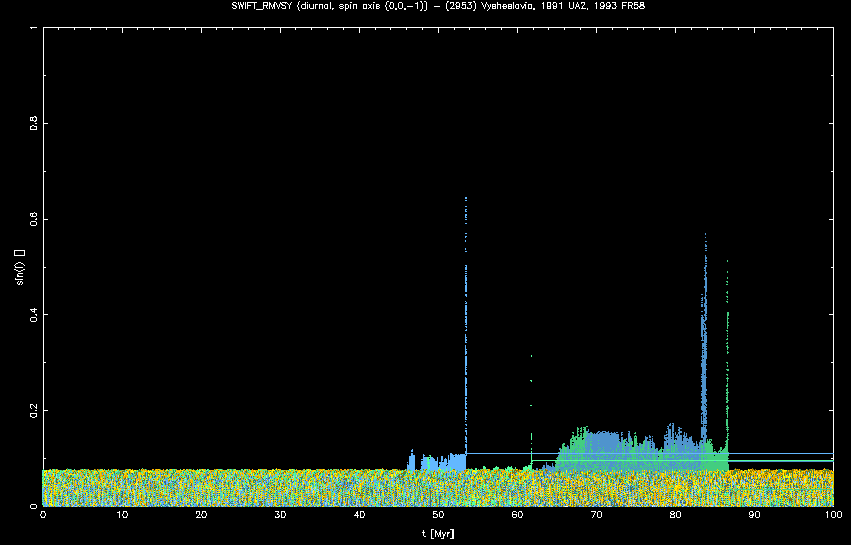 |
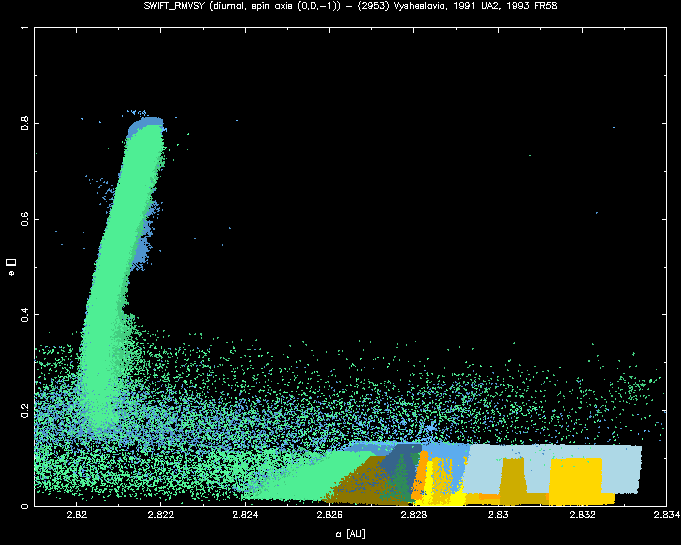 |
Another three graphs - e(t), sin(i)(t), (a, e) plane - serve a more complete view on the situation around (2953) Vysheslavia. The strong 5:2 mean motion resonance increases eccentricity upto 0.8 and this cause asteroids become even Venus crossers.
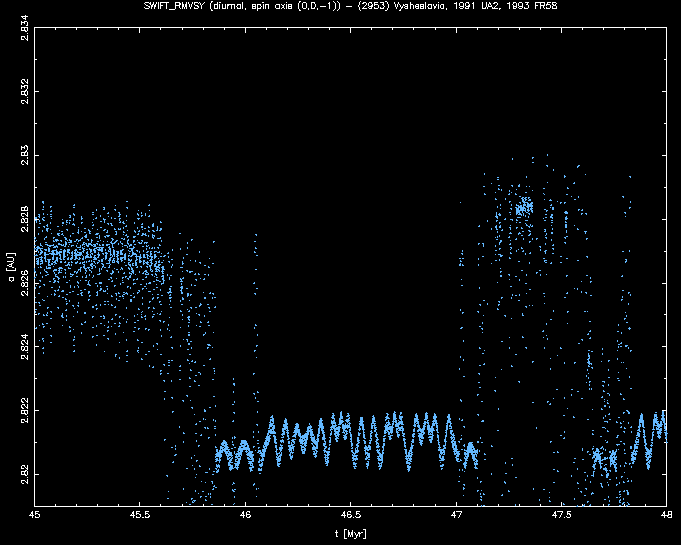 |
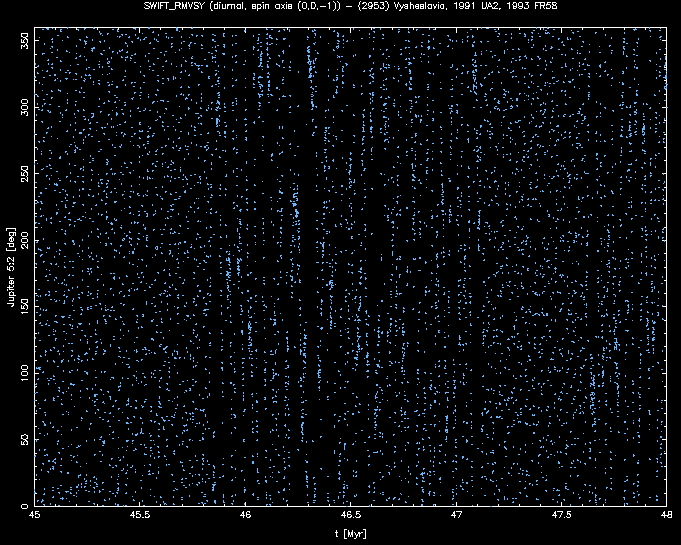 |
We selected a detail from a(t) graph to show a capture in the 5:2 resonance - the fourth clone of 1993 FR58 (ie. initial semimajor axis shifted 0.004 towards the predicted resonance border). The second graph is a dependece of critical angle on time for the same interval. The circulations of this angle could be seen, however output time step is 492 yr, which could be too high to plot a critical angle of a mean motion resonance.
 |
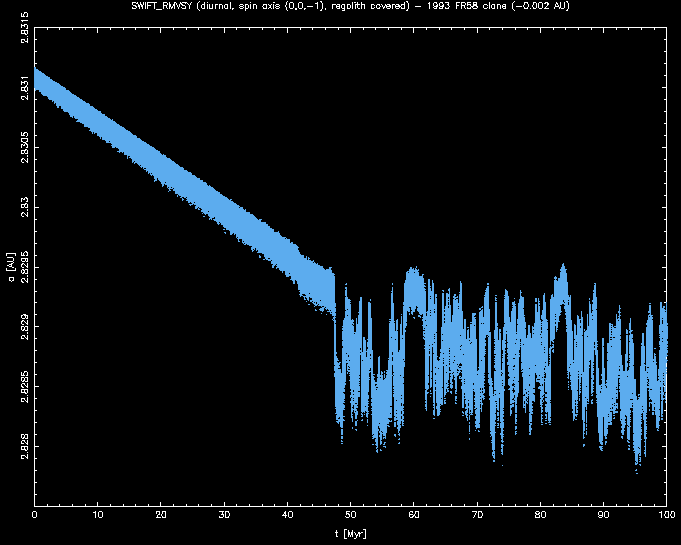 |
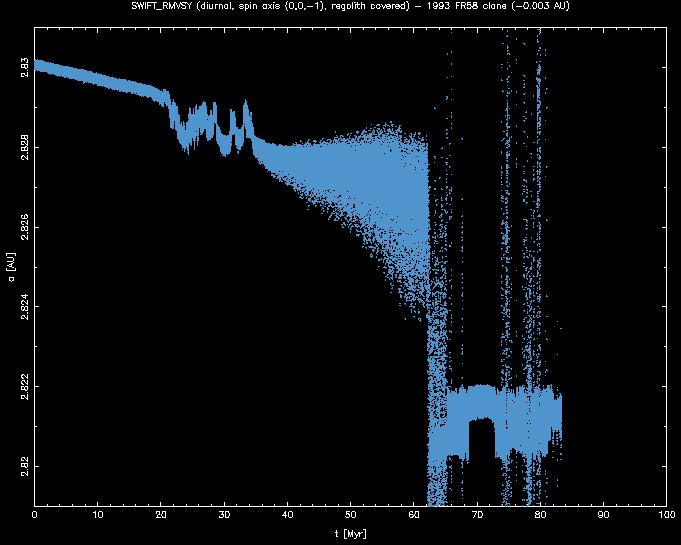 |
Another three details from a(t) graph show qualitatively different type of asteroid behavior.
| (1) | is (2953) Vysheslavia itself - the body stays in the chaotic zone for the whole 100 Myr. |
| (2) | 1993 FR58 clone (-0.002 AU) - initially the asteroid is quite far from chaotic zone, but it drifts inward and after 50 Myr is captured for the rest of the integration time. Notice that the capture span a longer time than continuous drift throug the chaotic zone. |
| (3) | 1993 FR59 clone (-0.003 AU) - simillary as in (2) the body is outward but closer and it drifts through the chaotic zone. |
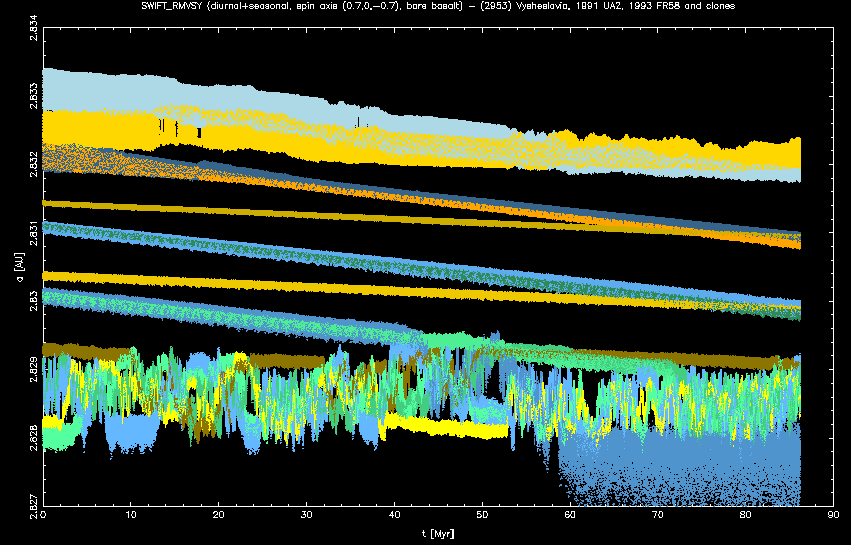
First 85 Myr of evolution of (2953) Vysheslavia and another 14 asteroids. Thermal properties are similar to bare basalt bodies - look in table 2. The unit vector of spin axes of all asteroids is (0.7, 0, -0.7) and this implies that both diurnal and seasonal Yarkovsky forces take effect and cause drag, however the drift rate of semimajor axis is smaller than in previous case. It could be the reason of important differences visible on a(t) graph - the chaotic zone captures particles for a longer time and prevents them against the fall into the resonance.
We will analyze the outer border of chaotic zone (between 2.8292 and 2.8294 AU) and look for the mixed mean motion resonances with Jupiter and Saturn.
| radius | bulk density |
surface density |
thermal conductivity |
specific heat |
albedo | emissivity | period [h] | spin axis orientation |
|
| 2953 Vysheslavia | 7500 | 3500 | 3500 | 2.65 | 680 | 0.2 | 0.9 | 10 | (0.7,0,-0.7) |
| 1991 UA2 | 2800 | 3500 | 3500 | 2.65 | 680 | 0.2 | 0.9 | 5 | (0.7,0,-0.7) |
| 1993 FR58 | 3000 | 3500 | 3500 | 2.65 | 680 | 0.2 | 0.9 | 5 | (0.7,0,-0.7) |
